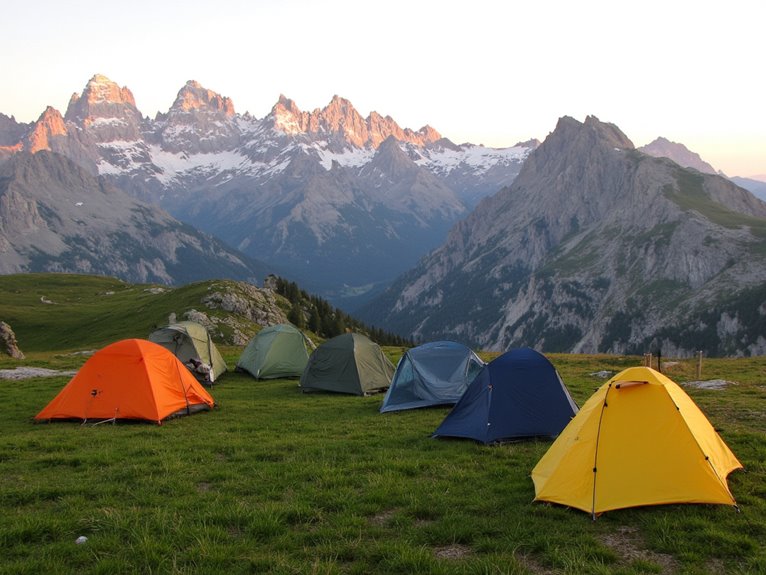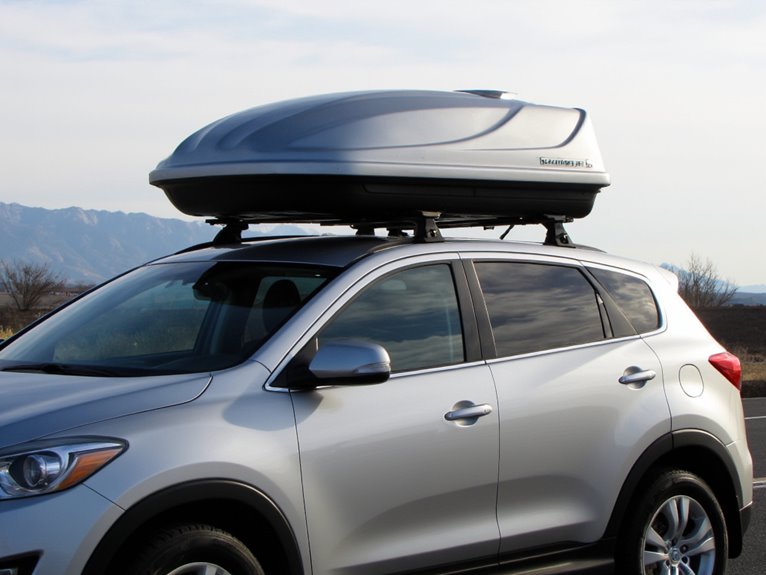What Age Can a Baby Go in a Hiking Backpack?
Babies typically develop the necessary physical strength and coordination to participate in hiking activities around six to seven months, when they can support their own head and torso while in a carrier. This milestone marks a common introduction to hiking backpacks. As babies grow, they continue to develop physically, reaching milestones that impact their ability to participate in outdoor activities like hiking. With careful consideration of weight and size limits, parents can choose the right carrier for their baby. And as they set out on this new adventure, they'll discover the secrets to a successful and enjoyable hiking experience for all.
We are supported by our audience. When you purchase through links on our site, we may earn an affiliate commission, at no extra cost for you. Learn more. Last update on 13th December 2025 / Images from Amazon Product Advertising API.
Physical Development Milestones
As babies grow and develop physically, they reach significant milestones that impact their ability to participate in outdoor activities like hiking.
One key milestone is achieving good head and neck control, typically around four to six months. This milestone enables them to maintain a stable position in a hiking backpack.
Another essential milestone is developing sufficient upper body strength, usually around six to seven months, which allows them to support their own head and torso while in a carrier.
As babies continue to grow, they'll develop the necessary strength and coordination to participate in more rigorous outdoor activities, making hiking a fun and accessible adventure for the whole family.
Weight and Size Considerations
When choosing a hiking backpack or baby carrier, parents must carefully consider their baby's weight and size to guarantee a comfortable and secure fit, as a proper fit is vital for both the baby's safety and the parent's comfort during the hike.
Most hiking backpacks and carriers have weight and size limits, typically ranging from 16 to 40 pounds (7 to 18 kg) and 16 to 32 inches (40 to 80 cm) in height.
It's essential to check the manufacturer's guidelines and verify the baby's weight and size fall within the recommended range.
Parents should also consider the baby's torso length, as some carriers may require a minimum torso length for proper fitting.
Baby Carrier Types and Options
Selecting the ideal baby carrier for hiking requires consideration of various types and options, each tailored to specific needs and preferences.
Frame carriers, such as backpack-style carriers, provide excellent support and ventilation for longer hikes.
Soft-structured carriers, like slings and wraps, offer flexibility and comfort for shorter trips.
Hybrid carriers combine the benefits of both, offering a sturdy frame with soft, padded straps.
Some carriers feature adjustable torso lengths, accommodating parents of varying heights.
Others boast built-in sunshades, storage compartments, or hydration sleeves.
When choosing a carrier, consider factors like weight capacity, comfort, and adjustability to guarantee a comfortable, enjoyable hike for both parent and baby.
Building Strength and Endurance
Before lacing up your hiking boots, it's vital to prepare your body for the demands of hiking with a baby, which requires building strength and endurance to ensure a safe and enjoyable experience for both parent and child.
To build the necessary strength and endurance, focus on the following exercises and activities:
Cardiovascular training: Engage in regular cardio exercises like brisk walking, jogging, or cycling to improve your overall fitness.
Core strengthening: Incorporate exercises that target your core muscles, such as planks, crunches, and leg raises, to improve your balance and stability.
Upper body strengthening: Focus on exercises that target your shoulders, back, and arms, such as push-ups, rows, and shoulder presses, to build the strength needed to carry your baby.
Practice with weight: Gradually increase the weight you carry on your back to simulate the weight of your baby and build up your endurance.
Emotional Readiness and Patience
As you prepare to hit the trails with your little one, it's essential to acknowledge that emotional readiness and patience are just as vital as physical preparation.
By embracing your parental instincts, building trust quickly, and learning to calm fussy moments, you'll be better equipped to handle the unexpected challenges that arise when hiking with a baby.
Embracing Parental Instincts
Embracing parental instincts is essential when hiking with a baby, as it allows you to tap into your natural ability to respond to your child's needs, even in the most unexpected wilderness scenarios. When you trust your instincts, you can react swiftly to your baby's cues, ensuring their comfort and safety. This intuition is crucial when navigating unfamiliar terrain with your little one in tow.
To tap into your parental instincts, remember:
Trust your gut: If you sense something is amiss, it's better to err on the side of caution.
Stay present: Focus on the moment, and respond to your baby's needs as they arise.
Be flexible: Be prepared to adjust your plans if your baby becomes uncomfortable or distressed.
Prioritize bonding: Use this shared experience to strengthen your connection with your child, fostering a deeper sense of trust and understanding.
Building Trust Quickly
Establishing trust between parent and child is essential when venturing into the wilderness, and this foundation is built on the pillars of emotional readiness and patience.
As parents, it's imperative to recognize and validate our child's emotions, creating a sense of security and trust. This emotional readiness allows our little ones to feel comfortable in new and unfamiliar environments, making them more receptive to the hiking experience.
By being patient and attentive, we can build trust quickly, fostering a strong bond between parent and child. This trust is indispensable in the wilderness, where unexpected situations may arise, and a strong parent-child connection can make all the difference.
Calming Fussy Moments
When venturing into the wilderness with a baby, even the most well-planned excursions can be derailed by a fussy infant, making it imperative for parents to develop strategies for calming their little ones in the midst of nature.
A calm and patient parent is essential in soothing a distressed baby.
To calm fussy moments, try the following:
Verify physical needs: Confirm the baby's basic needs are met, such as hunger, thirst, or a dirty diaper.
Provide comfort: Offer a pacifier, breastfeeding, or a gentle rocking motion to calm the baby.
Distract with nature: Use the natural surroundings to distract the baby, such as pointing out birds or leaves.
Take a break: If needed, take a break and find a quiet spot to calm down together.
Choosing the Right Backpack
In regards to choosing the right backpack for hiking with a baby, there are several key considerations to keep in mind.
Two of the most critical factors are the backpack's weight capacity and the comfort of its shoulder straps.
Backpack Weight Capacity
One of the most critical considerations when choosing a backpack for hiking with a baby is selecting a model that can comfortably accommodate the combined weight of your child, diapers, food, and other essential gear.
When evaluating backpacks, consider the following key factors:
Weight capacity: Verify that the backpack can handle the total weight of your child, gear, and supplies.
Distribution of weight: Opt for a backpack with padded shoulder straps and hip belts to distribute the weight evenly.
Stability and balance: Choose a backpack with a low center of gravity to prevent tipping or shifting during hiking.
Adjustability: Select a backpack with adjustable torso lengths and shoulder straps to accommodate your child's growth, guaranteeing a secure and comfortable fit as they develop.
Comfortable Shoulder Straps
As you set out on the journey of finding the perfect backpack for hiking with your baby, comfortable shoulder straps emerge as a crucial aspect to prioritize, ensuring that the weight of your child and gear is distributed evenly and comfortably across your shoulders.
Look for straps with thick, breathable padding and adjustable torso lengths to customize the fit. Additionally, consider straps with load lifter straps, which help to redistribute the weight and alleviate pressure points.
A well-designed shoulder strap system will make all the difference on long hikes, allowing you to focus on the adventure ahead rather than discomfort. By prioritizing comfortable shoulder straps, you'll be able to enjoy the great outdoors with your baby in tow.
Safety Features to Look For
Three essential safety features to prioritize when selecting a baby carrier for hiking are a sturdy, adjustable harness, a secure and comfortable infant compartment, and a reliable buckle system. These features guarantee your baby's safety and comfort while exploring the great outdoors.
Additionally, consider the following safety features:
- Weight distribution: A carrier that distributes the baby's weight evenly, reducing strain on your back and shoulders.
- Impact protection: A carrier with built-in protection, such as foam or air-filled cells, to absorb shocks and bumps.
- Visibility: A carrier with reflective materials or bright colors to increase visibility in low-light conditions.
- Certifications: Look for carriers that meet or exceed international safety standards, such as the American Society for Testing and Materials (ASTM) or the European Union's General Safety Regulation (GPSR).
Parental Fitness and Preparation
Before hitting the trails, it's essential to assess your physical readiness and prepare your body for the demands of hiking with a baby.
Hiking with a baby requires a higher level of fitness due to the added weight and bulk of the baby carrier.
Start by building your endurance with shorter, more frequent hikes, gradually increasing your distance and intensity.
Focus on strengthening your core, legs, and back to handle the extra load.
Practice hiking with a weighted pack to simulate the added weight of your baby.
Additionally, consider taking a first-aid course and learning basic baby care on the go.
Being physically prepared will guarantee a safe and enjoyable hiking experience for both you and your baby.
Realistic Expectations and Planning
When planning a hike with your baby, it's vital to set realistic expectations about the distance, duration, and terrain you can tackle, taking into account your baby's age, weather conditions, and your own physical limitations. This will help you avoid frustration and ensure a safe and enjoyable experience for both you and your baby.
To set realistic expectations, consider the following:
Start small: Begin with short, easy hikes and gradually increase distance and difficulty as you and your baby become more comfortable.
Know your limits: Be honest about your physical capabilities and don't push yourself too hard, especially if you're new to hiking with a baby.
Check the forecast: Avoid hiking in extreme weather conditions, such as heavy rain or extreme heat, which can be dangerous for your baby.
Pack wisely: Bring essentials like diapers, snacks, and extra clothes to ensure you're prepared for any situation.


